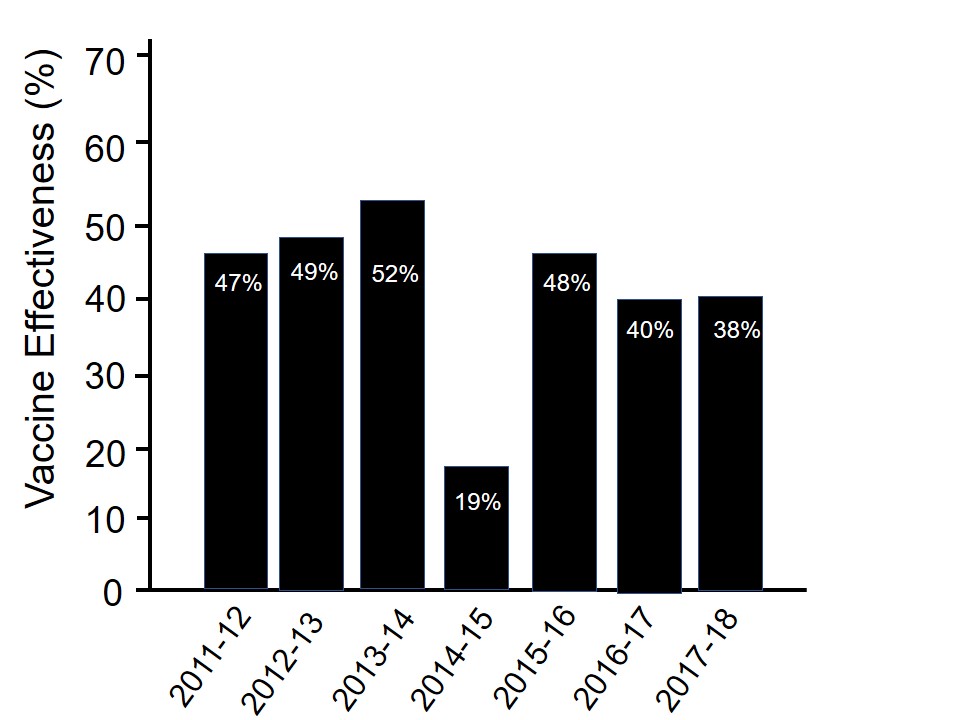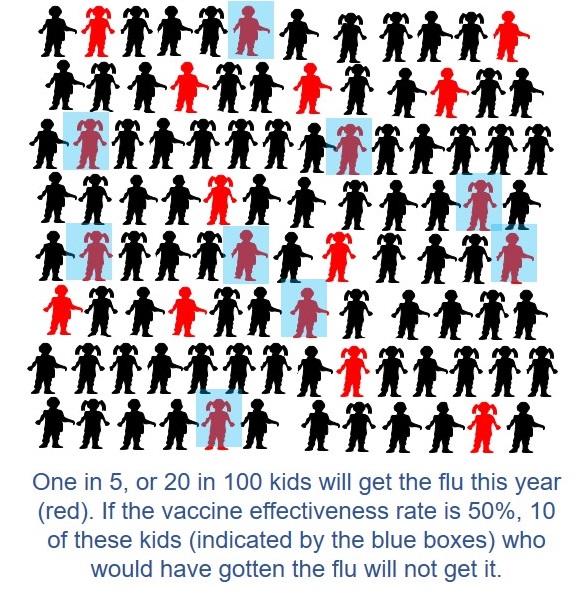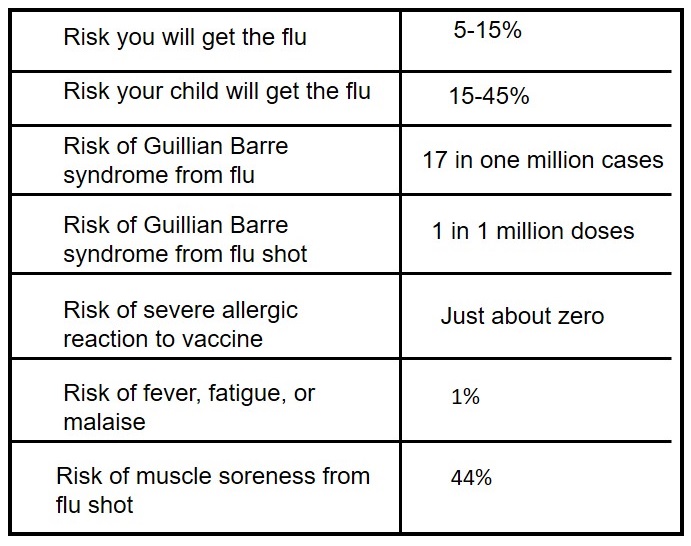Years ago, one of my very best friends from high school called me up because she had a baby and wanted some scientific advice. She was trying to decide whether to get her baby a flu shot at the 6-month visit and asked me what I thought about it from a scientific perspective. At that time, I wasn’t at all up on the debate. I wasn’t a mom yet, the flu shot was quite new, and I was always too busy to take myself to the pharmacy to get a shot. Not only that, but I hadn’t had the flu in who knows how long (I now call that a freakishly long and lucky flu vacation), and I didn’t see a real need to get the shot. But none of those thoughts were based on any real evidence, and my friend WAS asking for real evidence, so into the scientific literature I went, and I found out some interesting things.
First of all, what’s in the flu shot?
1. The virus!
For the flu shot to protect you against the flu virus, it needs to present the flu virus to your body so your immune system stumbles across it and says “Hey! That flu virus thing isn’t something friendly!”. Your immune system then goes into factory mode and churns out a whole bunch of antibodies designed to specifically recognize the flu virus if your body encounters it again so you can generate a protective response and wipe it out before it can take hold and become a full-fledged infection. This isn’t a new concept. Your body does this every time you get sick with a pathogen that you may have encountered in your home or the supermarket. Sometimes this process protects you completely and you don’t get sick from that pathogen again, and sometimes you just get a much milder form of the infection. Either way, the first time is usually the worst time when it comes to infections. The flu shot is just basically fooling your body into thinking it was already infected, so you skip that first awful time altogether.
Ok, so our bodies have to be exposed to the flu virus, which means that when we’re vaccinated, we’re getting copies of the flu virus injected into our bodies. Why don’t we get sick from that? Well, if someone injected fully activated flu virus into us, we certainly would get sick! But the pharmaceutical geniuses have found a couple of ways to make sure we don’t actually get infected by the vaccine. The first way (and the one you’ll be given if you go with the injectable form of the flu vaccine) is by killing the virus before it’s injected. The remnants of the killed virus is enough to generate those memory antibodies, and the body can recognize the live virus if it ever invades. The second way, which is used in the nasal form of the vaccine, is an attenuated (or weakened) form of the live virus.
2. An adjuvant:
Injecting just a few killed or weakened viruses into your muscle likely wouldn’t stimulate your immune system enough to produce enough protective antibodies against a real flu attack. So, scientists add another ingredient to help that response along. An adjuvant is a substance that enhances the body’s immune response. Aluminum salts are excellent adjuvants and are the only ones licensed for use in the US. When included in vaccines, they stimulate the immune system to generate lots of antibodies against the flu virus. Hundreds of millions of people have been injected with aluminum-containing vaccines over the past 70 years, and the only adverse reactions observed in association with aluminum (and only very rarely), include redness and inflammation at the injection site.
3. Preservatives and antibiotics:
If vaccines were made in a single dose vial and immediately injected into a person, then we wouldn’t need to add preservatives to them, but most vaccines are made in multi-dose vials to decrease the costs of them. In the early 1900s, many children developed fatal bacterial infections because they were injected with vaccine that came from multi-dose vials. Since then, multi-dose vials of vaccines are required to contain a preservative that inhibits the growth of bacteria and fungi in the vial, and that has since completely eradicated infections in people injected with doses from those multi-dose vials. The preservative used in the flu vaccine is called thimerosol, a mercury-based compound. While mercury itself is toxic, thimerosol quickly breaks down into ethylmercury, which is a form that is eliminated from the body within days. Despite this, many parents are still often concerned about the idea of having mercury in the vaccines, so there is a push to eliminate this preservative from the vaccines. The CDC reported that in 2019, 80% of the flu vaccine will be made in preservative-free single-dose vials, so you can ask your doctor specifically for that one if you are worried about the thimerosol. It may just take some extra time to order it if your doctor or pharmacy doesn’t already carry the preservative-free form. Vaccines also contain antibiotics to prevent bacterial growth. Some antibiotics such as penicillin have been known to cause allergic reactions in some people, but vaccines don’t contain those types of antibiotics. Instead, they contain mild antibiotics, such as streptomycin and neomycin. The only known side-effects of these include redness and swelling at the injection site.
4. A stabilizer:
Once you’ve got a nice sterile and effective vaccine, the last thing you want is for the virus in the vaccine to break down or stick to the side of the vial, or lose potency after exposure to heat and light. A stabilizer prevents that. The flu vaccine contains gelatin. The only known adverse reaction to gelatin is an allergic reaction, which is extremely rare, only occuring in 1 per 2 million doses of the vaccine. You may also see sucrose, sorbitol, and monosodium glutamate (MSG). Sucrose is the sugar you use in your cakes and coffee, sorbitol is found in higher levels in chewing gum than in your vaccine, and MSG is a common flavor enhancer that is found in way higher levels in your Chinese food. None of these are harmful at the concentrations that are present in vaccines, and all will help to make sure the vaccine actually works.
But I’ve heard the flu vaccine isn’t all that effective. What’s the deal?
So the next challenge when it comes to the flu vaccine is that the flu virus, unlike many of the other pathogens for which we receive vaccines, has an amazing ability to mutate or change. When someone is infected with a flu virus, the virus has one main goal – to replicate. While it’s making many copies of itself, it often makes little mistakes that changes the virus slightly. That new viral form replicates and spreads to other people. This means that there are different forms of the flu virus out there, and that the ones that are most prevalent can change from year to year. The flu vaccine only works if you are infected with the specific form that you were vaccinated with. So, every year, scientists sample the viruses circulating out there and make predictions about which will be the most prevalent forms the next year. They then construct a vaccine that contains either three or four of those predicted forms, and they hope that it actually matches the forms that become the most prevalent that year. Sometimes, they’re right on and the flu vaccine is extremely effective. Sometimes, the viruses give us all a surprise and mutate into even more forms that are not included in the vaccine. In that case, even if you got the vaccine, you’ll still be infected with the flu since the antibodies to the other forms don’t recognize the one you’ve got.
Below is a graph of the calculated effectiveness of the flu shot over the last 7 years. The data here are combined across all age groups that received the shot. If viral predictions are really off, you can get a bad year like 2014-15, when effectiveness was a low 19%, but because three to four viral forms are selected for each flu shot, effectiveness is generally much higher, hovering at just above 50%.

Even so, 50% still seems kinda low, right? When you compare the effectiveness of the flu vaccine to the other vaccinations that we receive as kids, it truly is low. When I saw those numbers, I thought “wow, really?Is it worth it?”. Sure, there is variation in terms of how effective it is. But I decided to think about the issue in terms of numbers. It has been estimated that children have anywhere from a 15-45% chance of getting the flu in a given year. Let’s be conservative and go with 20% for this example. That means 20 out of 100 kids will encounter the flu virus this year. If the flu vaccine is 50% effective, then 10 of those kids will be protected against the flu and the other 10 will get it. Frankly, if I was told that if I moved my kid a meter to the left, she was 50% less likely to get pegged in the arm by a baseball, I’d probably move her because who likes to get pegged with a baseball? Now getting her to the doctor and watching her feel the loveliness of a shot is a bit more involved than moving a meter to the left. Believe me, my daughter made sure I knew that her arm hurt from that shot for two straight days this year. But frankly, avoiding the sight of my kid suffering with a fever and all the wonderful symptoms of flu for a week or more is worth the shot for me and my family.

But what if the effectiveness is even lower? Is it still worth it? Well say that the vaccine is 25% effective, which would mean that your child would be protected one out of every four years. Now think about this. How badly do you feel when you have the full-blown flu? Pretty bad, right? During the height of one of those lovely fevers and respiratory infections, would you gladly get 4 shots to make it go away? Well then you just did, by getting the flu shot four years in a row. The same for your child. It would be wonderful if we had one shot that worked for all flu strains and you could just get one every 10 years and be done with it. Scientists agree, which is why they are constantly working to develop such a thing. The current flu shot is not perfect by far, but to date, it is the most effective way to avoid getting the flu, and maybe more importantly, to avoid passing it on to your young ones who are more susceptible to flu complications.
More susceptible to flu complications, you say?
Data from the CDC as well as independent peer-reviewed studies indicate that children, particularly those below the age of 5, have a significantly higher rate of flu infection compared to others in the population. The risk of getting the flu is as high as 45% in kids compared to about 15% for adults. In addition to that, when tested for flu, children in this age range have higher rates of viral shedding, which means that their nasal secretions are spreading the virus more than, say, yours would. This makes them even more infectious to other people. That daycare crud is starting make sense! Put a bunch of young kids with immature immune systems in a room together and you’re sure to get some excitement. Our whole family was sick for about a whole year straight when we first brought our two girls in to daycare. Luckily, that immunity does eventually develop. But for those sensitive years, protecting against the flu is even more important because kids are also more likely to end up in the hospital with flu related complications than we adults are. Even more importantly, babies younger than 6 months are the most susceptible and cannot yet get a flu vaccine. Flu vaccines for the rest of the family members reduce the risk of transmitting the virus to unprotected babies that are sensitive to it.
Common misconceptions about the flu vaccine
Ok, so I was undecided about the flu vaccine before, and after some thorough research, my opinion is that getting the flu shot is, indeed, worth it. If you don’t get it, will you likely die? No. The likelihood of a healthy adult dying from a seasonal flu is very very low, and while a child is more susceptible to complications, the risk is still not astronomical. So I understand why some might choose to avoid the needle. Maybe you’d rather have a couple weeks of flu than get a shot. Some people hate shots that much, and to each his/her own. Everyone has the right to make that choice. But when I was researching for this post, I came across something that I hate with all of my being, and that is fear mongering using false claims of “research-based” approaches. There are many people out there who are scared of the flu shot because they do not really understand how the ingredients and the body’s reactions to them work, and they take their own fears and their misunderstandings about human physiology and they make blog posts about them to scare you. I hate that. Can I say again that I hate that? I really really hate that. What right does someone who has absolutely no physiological or medical training have to instruct you on what to do with your body? I DO have physiological training, and I STILL wouldn’t tell you that you should do this or you should do that. All I can do is tell you what I found in the literature and let you make your decisions. So I have to get on my soapbox for just a second (please indulge me) and talk about the common misconceptions that are being touted against the flu shot so that when you come across these popular posts on Google, you can read them with some understanding of whether these “research-based” approaches are actually real. So here goes. Here are the most popular claims I’ve seen:
Concern #1: Flu shots can trigger allergic reactions
There are two components of the flu vaccine that could potentially trigger allergic reactions. One of those is egg protein, and the reason it is in there is simply because the vaccine is grown in eggs, so you have remnants of the egg protein in there. If you have an egg allergy, you probably know it because most people have tried to eat eggs at some point in their lives, and it would have caused an allergic reaction. What’s more, egg allergies are really quite rare, and even if an allergic reaction does occur in response to the egg in the flu vaccine, it isn’t likely to be severe. In a study of over 4,000 patients injected with the flu vaccine, 500 of which had an egg allergy, there were zero reports of severe allergic reactions. Some of those participants did experience mild allergic-like symptoms for about a day after injection. The other component that has, in the past, caused such a reaction in some people is gelatin. Allergic reactions to the gelatin component are even more rare (1 in every 2 million people will have one), and again, if you’ve successfully eaten Jell-O, you’re probably fine. If you do have an allergic reaction, you will know it quickly, and a simple injection of norepinephrine will mitigate the symptoms. So overall, this type of reaction is extremely rare, and extremely treatable if it were to happen. The flu, however, does not have a good treatment, and has a higher probability of landing you in the hospital than the flu shot does.
Concern #2: Aluminum is toxic and doesn’t belong in the body.
Actually, aluminum IS in your body all the time. We are exposed to many sources of aluminum every single day, and there is even aluminum in infant formula (with no adverse effects). What’s more, you are being injected with aluminum SALT in the flu vaccine, which is very different from injecting you with aluminum foil. The salt alerts your immune system that the vaccine is present and then quickly breaks down and gets excreted. There is no evidence that the aluminum component of the vaccine is harmful in any way, and that’s after 70 years worth of vaccinations containing aluminum with zero incidences of any serious reactions.
Concern #3: Thimerosol has mercury and mercury is toxic
Thimerosol is in fact a mercury-based compound, and yes, in high quantities and in the right form, mercury is toxic. If you drank too much water, that would be toxic too, but we don’t run away from drinking water just because of that. Thimerosol is a compound that quickly becomes ethylmercury, which is a harmless form of the molecule that breaks down within days. Even so, because of the concern over this molecule, 80% of the flu vaccines will be thimerosol-free this year, so just ask for a preservative-free vaccine if this concerns you.
Concern #4: There is formaldehyde in there
Yup, there is – a very tiny amount. In fact, it has been estimated by the FDA that there is 50 to 100 times the amount of formaldehyde naturally present in a newborn’s body as there is in the flu vaccine. I give you the same argument as I did with the water. Too much of anything can make you sick, and yes, too much formaldehyde is toxic, but the levels in a vaccine are WAY below toxic levels, and it helps to make sure that your vaccine doesn’t contain things that are even more dangerous – bacteria and fungi.
Concern #5: The flu shot makes you sick
Because the flu shot gives people flu-like symptoms within hours of the shot, many people think that the flu vaccine gave them the flu. But the reality is, what you’re experiencing in that case is simply the immune reaction to the vaccine. Think of it this way. If you get a common cold, you get a stuffy nose, sometimes a fever, and achiness. Well the cold itself didn’t make you feel all those things. Your nose is not stuffed up with virus particles. It’s stuffed up with mucus, because your body made the mucus to get rid of the virus. It’s part of your immune response. After you get the flu shot, sometimes your body thinks you have the flu (which is what you want your body to think after a vaccination) and it responds with an immune response that includes the production of antibodies (what you’re aiming for to protect you later) and also sometimes other symptoms like mucus production and fever. It goes away quickly when the body realized that you don’t actually have the flu. So no, the flu vaccine does not suppress your immune system and it does not make you sick.
Concern #6: The flu vaccine can cause Guillain-Barre Syndrome
This idea is scary to anyone – a disorder that can cause paralysis and land you in a hospital bed is quite scary. What actually happens in this case is that your immune system goes a little haywire and attacks your nerves, and this causes paralysis. Usually the paralysis subsides within a period of months, but occasionally it can last longer and even cause death. BUT, as scary as that is, a scientific study showed that the risks of getting this syndrome are actually higher from getting the actual flu than it is from getting a flu shot. Think about it – the flu and the flu vaccine are activating your immune system in the same way, only the flu gives you a much bigger systemic immune response, and so there is more chance for that immune response to get out of control. “But I see accounts like this all over the web” you might say. Well yes, the people who get those symptoms would definitely be more represented on the web in forums because those are the people who are driven to write about it. Think about it. After you get a vaccine and nothing happens, do you have the urge to go find a posting on flu vaccines and announce that you didn’t have symptoms? Probably not as much as those that did. The incidences of this disorder are nowhere near as high as they would seem based on what we see on the web.
So let’s boil it down to the numbers:

Overall, there are pluses and minuses to getting the flu shot, just like there are for any treatment or anything else that you do. You might end up with redness at the injection site and maybe some muscle pain as well. You might even get some flu-like symptoms for a couple of days. No one likes that. I personally get all of those side effects every single year, and I curse that darn shot every single year until the symptoms go away. But, at the end of the day those things are not particularly harmful, and I really hate the flu. And I hate the idea of my kids feeling sniffly and feverish even more. Is there a risk that the vaccine could come with side effects? Sure. But there is a much higher risk of getting in a car accident each time you drive than there is for getting a serious side effect from a flu shot. No one should need to fear monger you to make you get the vaccine, nor should they fear monger you to prevent you from it. Take the fear out if it, use the facts and the logic, and then make your decision about whether you and your family will get this vaccine.
Contributing References
https://www.cdc.gov/flu/vaccines-work/2017-2018.html
https://www.cdc.gov/flu/prevent/vaxsupply.htm
Offit, P. A., & Jew, R. K. (2003). Addressing parents’ concerns: do vaccines contain harmful preservatives, adjuvants, additives, or residuals?. Pediatrics, 112(6), 1394-1397.
Vellozzi, C., Iqbal, S., & Broder, K. (2014). Guillain-Barre syndrome, influenza, and influenza vaccination: the epidemiologic evidence. Clinical infectious diseases, 58(8), 1149-1155.
Des Roches, A., Paradis, L., Gagnon, R., Lemire, C., Bégin, P., Carr, S., Chan, E.S., Paradis, J., Frenette, L., Ouakki, M. and Benoît, M., 2012. Egg-allergic patients can be safely vaccinated against influenza. Journal of Allergy and Clinical Immunology, 130(5), pp.1213-1216.
Grohskopf, L.A., Olsen, S.J., Sokolow, L.Z., Bresee, J.S., Cox, N.J., Broder, K.R., Karron, R.A. and Walter, E.B., 2014. Prevention and control of seasonal influenza with vaccines: recommendations of the Advisory Committee on Immunization Practices (ACIP)—United States, 2014–15 influenza season. MMWR. Morbidity and mortality weekly report, 63(32), p.691.
Nichol, K. L., Margolis, K. L., Lind, A., Murdoch, M., McFadden, R., Hauge, M., … & Drake, M. (1996). Side effects associated with influenza vaccination in healthy working adults: a randomized, placebo-controlled trial. Archives of Internal Medicine, 156(14), 1546-1550.









